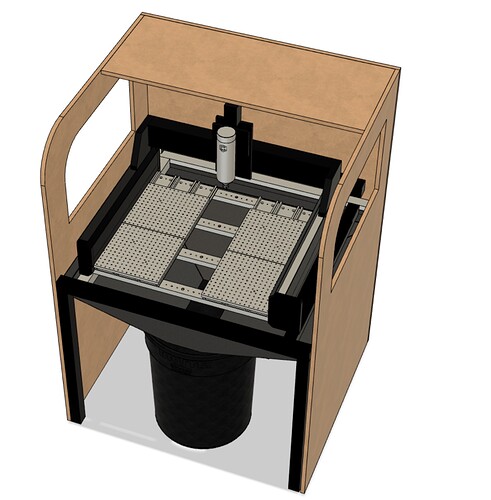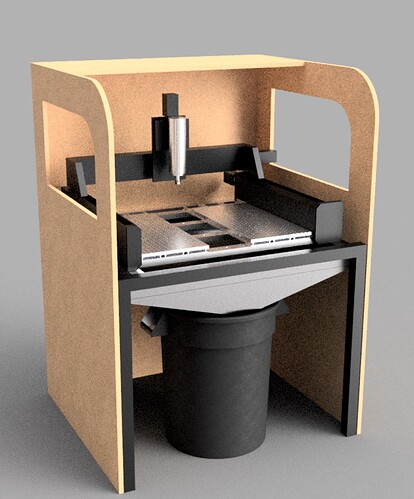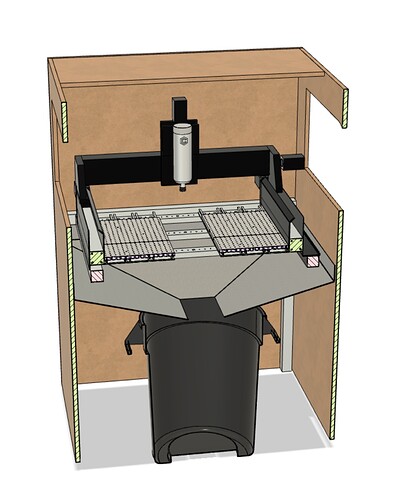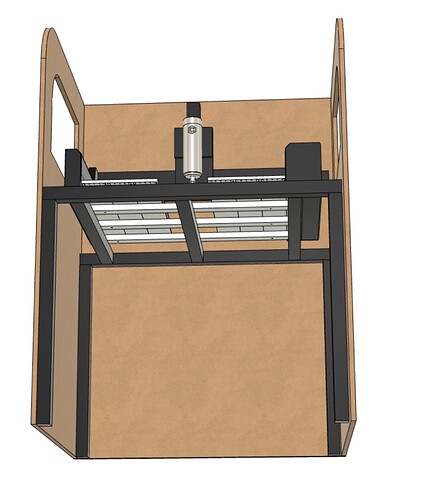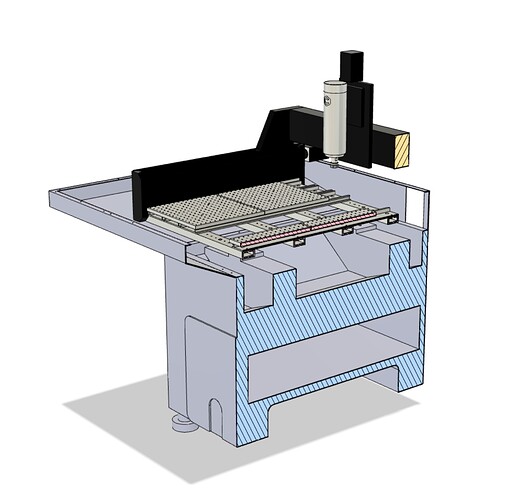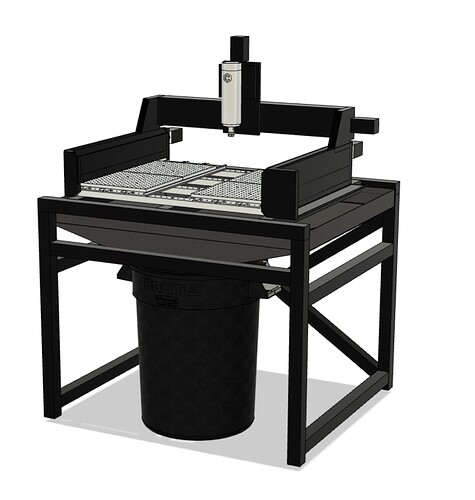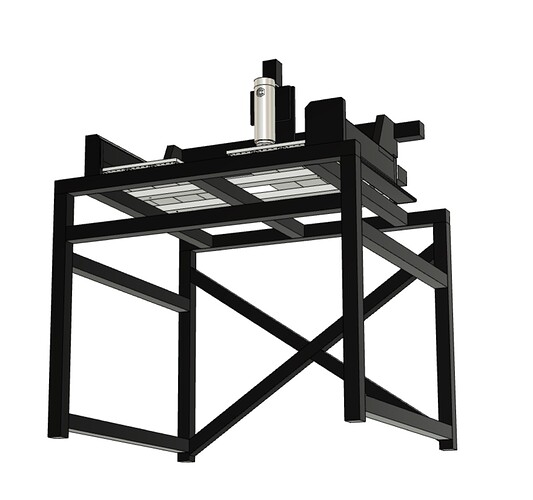Placeholder for existing topic.
I have been cutting aluminum on my Pro for a while and as I wait for my HDM I am thinking of ways to make my life a bit easier when it comes to chip build up, collection, etc. Here are some images of what I am envisioning. I will cut and weld a custom base and build the metal tray to catch the chips. Would love to see other’s ideas on how to make the new HDM more livable for a lot of aluminum cutting.
Obviously I will add doors and a platform for the chiller and controls.
Has anyone tried a sandwich construction on the walls to reduce noise in the shop?
Love the design.
As for noise reduction, I live in an apartment building and use my Shapeoko 3 to mill aluminum from time to time. It is very loud and not something I do often so as to not piss off my neighbors. I have given a ton of thought on what my next enclosure is going to be for optimum noise reduction so that I can do it more often.
- Make the Shapeoko as heavy as possible. More weight means the same amount of energy generated by the machine for making vibrations will generate lower amplitude vibrations. This is why I filled my rails with sand and put it up on garden pavers.
- Decouple the Shapeoko from the enclosure. I have those garden pavers up on multiple layers of EVA foam. Next time I plan to use dense neoprene rubber. This helps to prevent any vibrations from the machine going through the frame of my enclosure and vibrating it.
- I plan to build my next enclosure like I would a house. The top and bottom plate of the walls will be 1x4s. The studs will be made out of 1x3s. The studs for the inside walls of the enclosure will be different than the studs for the outside walls of the enclosure. This way the studs holding up the interior walls will not transfer the vibrations to the exterior walls. Only the top and bottom plates will.
- The walls will be sheathed in sound insulating drywall.
- In between the drywall I plan on putting sound absorbing insultation.
- On the inside of the enclosure I will cut up a 2x2s into chunks between 0.25in and 0.75in in random length and then laying that out in a random pattern. This will break up the sound waves moving through the air as they hit the wall, reducing the reverberations inside the enclosure.
- All that will get painted in some heavy duty paint to prevent lubricant and coolant from ruining things.
- In the top of the enclosure there will be an air duct that snakes back and forth at odd angles and will be lined with carpet. This will allow air to flow into and out of the enclosure but will get the sound waves trapped / absorbed.
About the only thing I have not figured out how to insulate well for sound is the windows I want to put in it. If they were not so hard to come by during this building boom I would try to use a double paned house window.
Looks cool. As long as the frame is REALLY sturdy. All the mass of the HDM moving at 200 IPM will make a frame rock around a lot. Plenty of cross bracing would help that a lot. I do like the idea of a chute under it to auto correct chips. But the plates on the far sides loose A LOT of usable area. Keep in mind that a couple inches on each side is not in the cutting area. My personal suggestion is to have the sides open for chip droppage and leave all the center for cutting. 
Agree on the need to make it solid, I’m building it like my welding tables so solid as a rock. I was planning on figuring out the best placement for the plates when I get the hdm, but center probably Will be best.
I have the SMW plates and mod vises arriving Monday. I plan on them being oriented with the longer dimension in X. That way they maximize usable travel. That would still give you the ability to dump chips on the sides, although you’ll likely have to mill the extrusions to get a good slot while still retaining the t-slot to mount it.
Sounds like a solid plan (puns intended)
I have had quite a bit of success lining boxes containing noisy things with this stuff
https://www.trimacoustics.co.uk/product/srs-acoustilay/
It works to both absorb medium to high frequency sounds both
- On the inside wall of the enclosure or inbetween the two walls if a sandwich, I’d still separate the structure of the inside and outside walls as you plan to, mechanical coupling makes it very hard to reduce transmission otherwise
- As a ‘floating base’ mat, I would suggest trying this stuff as the base rubbery stuff under the pavers, it is specifically designed to reduce noise transmission to the floor, including people walking
I’ve used it in domestic and studio locations
One thing the model seems to suggest is that the machine is being supported by the drag chain tray on the right side. I may be missing something, but if that’s the case, you’d need to move that aspect of the enclosure table.
I need to figure out where the best mount points are, without having the machine it is a guess right now. I did add another support down the middle and moved the one based on your feedback. I have been looking at the HDM inside a 770MX enclosure to see how I could make something that works well and is solid too.
And some more finished door and front opening looks… I need to finalize to start building so its ready when the HDM arrives!
If there’s any chance, I’d recommend a bit more space on the front side… when doing a bit change etc the spindle will come up and forward, need to make sure it doesn’t bump into your very nice front cover…
(and also need to model in the vacuum hose/sweepy)
what @fenrus said: you need to be able to accomodate the dust collection, and more often than not that means a dust shoe that extends in front of the spindle.
Agreed, I will probably never run wood on the HDM, so I will put in a vacuum hose inside like I have in my PRO’s enclosure. With the bitsetter being on the wasteboard slots with the HDM I assumed it won’t need much front clearance?
True, you don’t need much clearance, but it turns out to be quite convenient to have “some” (YMMV), and if you’re going to make a fancy enclosure we just don’t want you to beat yourself up later ![]()
The main use I have for the space just in front of my machine (not an HDM though) is a rubber pad installed at the tool change position. This has saved the life of my (falling) endmills more than once.
Looking better. I would refine it with some more X bracing like in this SUPER awesome pic. 
If you plan on cutting plastic or composite, I do recommend dust collection. I also second (third, what ever) leaving a little run in the from for the gadget moving forward.
Have you thought about making things watertightish so that you have the option of flood coolant? It’s something I’m starting to consider for my build.
Funny you say that, I have been thinking more and more about that too, found this guys DIY conveyor for chips…
slippery slope for sure, I almost bought a tormach 1100 for that reason but the parts we are making require some aluminum stock that is bigger, so we went back to the HDM. I figured spending 30+ and not being able to do parts that I needed too was going to be an issue. But as I try to make the HDM a VMC I may find the $$ would be worth it?
I don’t think we even need chip conveyors at our scale. What I was thinking is that if you put a filter in your chip funnel to catch the chips, you could basically just add a pump and nozzle and run flood coolant, using your bucket as a reservoir, without any additional effort.
All a chip conveyor would do is increase the time between cleaning the filter.
